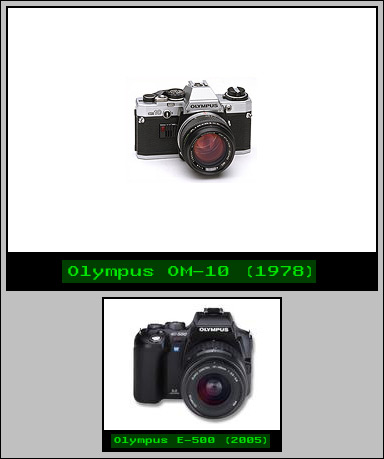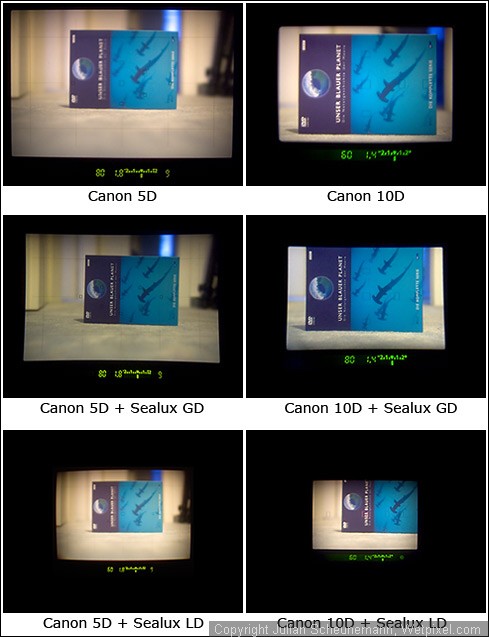Standard versus Enhanced Viewfinders - Size Matters

I remember writing here on the forums, “2006 is going to become the year of enhanced underwater housing viewfinders.” Well, actually this year (2007) they seem to have become really popular as most housing manufactures start to offer something. In the film past, Seacam was the first one offering even two versions with 1:1 magnification: a straight one and a 45° angled one. Sealux followed with the straight GD viewfinder (later, in the digital age, it has been adapted onto Subal housings too: GS viewfinder). For years no manufacture followed. It was kind of a luxury during film days to have it.
Things became a bit different with digital SLR cameras. Most of them don’t stick to the 35mm format anymore. If you crop the sensor down to APS size your viewfinder image is cropped accordingly. If you have a look at APS camera specs you can see that most manufactures gained the viewfinder magnification compared to 35mm cameras. But that doesn’t mean the overall viewfinder image size is greater compared to 35mm cameras. The reason is that the magnification factor has to be applied to the image your camera captures (cropped to APS). Although magnification is increased in order to compensate viewfinder size loss up to some degree, APS cameras still have the smaller finder picture compared to 35mm cameras.

Film/sensor size impact on viewfinder size:
Olympus OM-10 35mm film camera vs. Olympus E-500 Four Thirds
(Drawing according to camera’s specs)
What do simple underwater housing viewfinders do? They shrink the viewfinder picture of your camera. This allows you to view the entire frame through the diving mask. Just a few housing manufactures state the magnification. Sealux for examples states 1:1.6 for their simple LD viewfinder. That means your camera viewfinder size is shrunk by 1.6. Some state the magnification as a factor like 0.66. That means 66% of your camera’s viewfinder size is left if you put the camera inside the housing. As you can see the overall viewfinder image size underwater is not just determined by the underwater housing optics. It’s actually the result of your camera’s viewfinder size and the underwater housing’s finder optics (magnification factor).
Things have become a bit more critical with digital APS cameras because the simple housing finders now shrink an already cropped camera viewfinder image even further. I have to say that people feel differently about it because it depends on what you have been used to before and if you wear glasses, if you want to focus manually, etc. And there are still noticeable differences among different APS camera models and housing brands. But in general, we have to deal with smaller viewfinders underwater since digital APS cameras and especially Four-Thirds cameras came along.
Different from simple housing optics, enhanced viewfinders almost maintain the size of the camera’s viewfinder underwater (close to 1:1). This helps a lot in combination with APS cameras. You still have a smaller/cropped viewfinder but it isn’t shrunk further by the housing viewfinder. But again, the final viewfinder image size underwater is based on your camera’s viewfinder size. This means if you use an enhanced housing finder in conjunction with a very small APS or even Four-Thirds camera you could theoretically end up with the same size underwater like some 35mm camera combined with just a simple housing finder.
Note: You might read somewhere that enhanced housing finders enlarge the camera’s viewfinder image. I’ve recently read that in a German dive magazine. It’s simply not true. Enhanced finders “just” maintain the camera’s viewfinder size. They usually come close to a magnification of 1:1.
Following comparison shows different combinations with an APS camera (Canon 10D) and a 35mm camera (Canon 5D) in conjunction with a simple and an enhanced viewfinder (Sealux LD / GD). This is a quick and dirty comparison and there are several inaccuracies included like:
- Topside. Although the optical influence of the diving mask applies to different setups in the same manner.
- Imprecise alignment. Sealux send me the LD viewfinder for this comparison. It has simply been placed right onto the cameras’ viewfinders (no underwater housing). I didn’t make a scientific 100% alignment. Few degrees misalignment and some millimeters distance quickly cause a slightly distorted image.
- Lens error. Distortion from the lens taking these wide-angle close-ups with - don’t mistake it as finder’s flaw.

However, I think the comparison still provides an idea of what’s going on with different cameras and housing finder optics. The best comparison is side by side in your hands. But I think a lot of people might not have the opportunity before buying (like me). So I hope this can give you at least some rough idea. But keep in mind that there are several more important points to consider about housing finders than just the image size. For example: The margin against corner shading. Some housing finders are more critical than others. Again, this depends on the combination of housing finder and camera. Bigger camera viewfinders evoke less margin against corner shading if you align your eye with the housing finder.
So the best way to check is to try an enhanced viewfinder with the camera you want to use with it. If you have the opportunity, do it underwater. My Sealux GD finder for example got more critical in terms of margin against corner shading when I switched from 10D (APS) to 5D (35mm). But I didn’t have to pay attention underwater because it wasn’t even noticeable to me during real underwater shooting. Instead I enjoy the bigger finder picture.
Camera viewfinder specs
It was easy to read film camera specs in the past. Magnification (like x0.75) and coverage (like 95%) could be compared directly to other camera models in order to get an idea of the viewfinder size. Now we have to take the picture size (sensor size) into the equation. The spreadsheet includes some camera models from 35mm down to Four Thirds. I have included some film cameras too. You can see that the sensor size has a strong impact on the resulting viewfinder size.
Another thing is the viewfinder brightness. Higher magnification basically results in a slightly dimmer viewfinder image. It’s pretty much like a slide projector. If you put it further away from the canvas the image becomes bigger but less bright. But I don’t see this as a critical point to consider. There are stronger influences on the viewfinder brightness in real life: Lens’ open aperture, built-in focus screen and the light conditions you shoot in of course. I have just included the theoretical(!) brightness into the spreadsheet in shape of different bright grey tones. It looks more dramatic than it is.

Note that the chart is based on copied viewfinder specs (mainly from www.dpreview.com) and we know that manufactures love to round values in an advantageous way :-)
-Julian Scheunemann